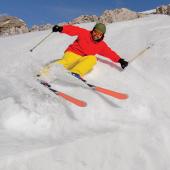Why Do ACL Injuries Occur?
Alpine skiing, enjoyed by 200 million people worldwide, is commonly associated with knee injuries. Severe knee sprains involving the anterior cruciate ligament (ACL) are the most common injuries in alpine skiing and result from a combination of factors, including modern equipment design and skiing technique. More than 100,000 ACL injuries occur annually in the United States. Women are twice as likely to sustain a severe knee sprain while skiing. Other sports that place athletes at risk for knee injuries include soccer, basketball, and football. These sports all require rapid deceleration, combined with pivoting and cutting maneuvers.
Ligaments are specialized collagen tissues that connect a bone to a bone. In the knee, ligaments connect the thigh bone (femur) to the leg bone (tibia). There are four primary knee ligaments. Two of them are in the middle of the knee and form a cross (cruciaform), and are therefore called cruciate ligaments. The ACL attaches the back of the femur to the front of the tibia and is substantially responsible for knee stability.
ACL tears represent a significant injury that can have a profound effect on activity levels and quality of life. Although the exact cause or mechanism of ACL injuries in skiing is unknown, there are specific body positions that place a skier at risk. Several investigators have determined, by videotape analysis of actual injuries, that being off-balance to the rear, with hips below the knees and rotating the upper body toward the downhill ski, places the skier at risk for injury.
In addition, landing a jump off-balance on an extended knee places the skier at risk. Falling forward and catching one or both ski tips on the snow can also place the skier in a vulnerable position. Video analysis has demonstrated that an athlete’s center of gravity was often located behind the knee during an injury. Educational programs directed at identifying and correcting these positions have been successful in decreasing injury rates by 50%-60%.
Developments in ski/boot/binding technology and calibration have been primarily directed at preventing tibia (lower leg) fractures. The proper use of modern bindings has resulted in an 80%-95% decrease in lower leg and ankle fractures in adults in the last 30 years. Standards for calibrating bindings were recently updated to address the persistent high rate of lower-leg fractures in children.
An unfortunate side effect of reducing rotational forces to the lower leg and tibia fracture risk is that increased force is transmitted to the knee, increasing severe knee sprains by over 200% during the same time period. The ski-boot-binding system is currently unable to detect when the knee or ACL is at risk. High-risk body positions impart unique shear and rotational forces to the knee, possibly exceeding the material properties of the ACL and cause it to rupture.
Why do ACL tears require surgery?
A careful history and physical examination is typically all that is required to identify the presence of an ACL injury. A skier describing a “yard-sale” mechanism of injury and a “pop” in the knee with significant swelling probably has a torn ACL. Attempts at bearing weight after the injury may be accompanied by complaints of instability or giving way. Physical examination confirms the diagnosis.
An x-ray is taken to ensure that there are no fractures or broken bones. After the examination and diagnosis, an initial treatment plan can include bracing, temporary use of crutches, icing, elevation, pain medications, and rehabilitation.
Certain injuries respond well to this program, particularly minor to moderate sprains of the medial collateral ligament (MCL). The collateral ligaments are located within the capsule (envelope) of the knee and therefore are surrounded by tissues that provide blood supply and an ideal environment for healing.
In contrast to the collateral ligaments, the cruciate ligaments (including the ACL) are located in the direct center of the knee, have very little surrounding tissue, and therefore have minimal, if any, blood supply after they are ruptured. The ACL, therefore, has limited capacity to heal on its own.
The decision to surgically reconstruct an ACL is based on the presence of instability as well as lifestyle and activity level. A knee that lacks a stable, intact ACL is vulnerable to giving way as well as to the degeneration of the meniscus and cartilage. This is particularly true for individuals participating in high-demand sports. Due to the lack of healing capacity, active individuals often choose to have the ACL replaced (reconstructed) with other tendons around the knee to reestablish stability and function. Complete healing following ACL reconstruction involves an extensive rehabilitation program focusing on full restoration of strength and range of motion.
Mark C. Deibert, M.D., is a orthopedic surgeon with Alpine Orthopedics and Sports Medicine, P.C., in Bozeman, 586-8029.











